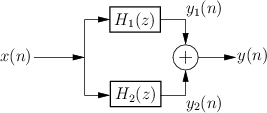Parallel Case
Figure 6.2 illustrates the parallel combination of two
filters. The filters ![]() and
and ![]() are driven by the
same input signal
are driven by the
same input signal ![]() , and their respective outputs
, and their respective outputs ![]() and
and ![]() are summed. The transfer function of the parallel
combination is therefore
are summed. The transfer function of the parallel
combination is therefore

Series Combination is Commutative
Since multiplication of complex numbers is commutative, we have
By the convolution theorem for z transforms, commutativity of a product of transfer functions implies that convolution is commutative:
Next Section:
Example
Previous Section:
Series Case





















